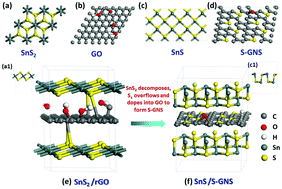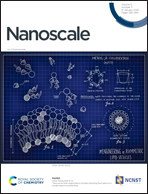Structural phase transformation from SnS2/reduced graphene oxide to SnS/sulfur-doped graphene and its lithium storage properties†
Abstract
In this work, we demonstrate an interesting structural phase transition from SnS2/reduced graphene oxide to SnS/sulfur-doped graphene at a moderate calcination temperature of 500 °C under an inert atmosphere. It is discovered that SnS2 chemically bound to rGO with a weakened C–S bond is easier to break and decompose into SnS, whereas it is difficult for pure-phase crystalline SnS2 to experience phase transformation at this temperature. Moreover, the thin-layered structure of SnS2 and rGO is an important factor for the effective doping of the dissociated Sx into graphene. Density functional theory calculations also reveal the feasibility of the structural phase transition process. Morphology characterization shows that partial SnS maintains the original nanosheet structure (∼100 nm) and the others are decomposed into tiny nanoparticles (10–20 nm). A high S-doping amount reduces the irreversible lithium storage sites on graphene, and the first coulombic efficiency is as high as 81.7%. In addition, thin-layered and small-sized SnS can alleviate the structural damage caused by volume expansion and shrinkage; therefore, a high specific capacity of 893.9 mA h g−1 is retained after 100 cycles.



 Please wait while we load your content...
Please wait while we load your content...